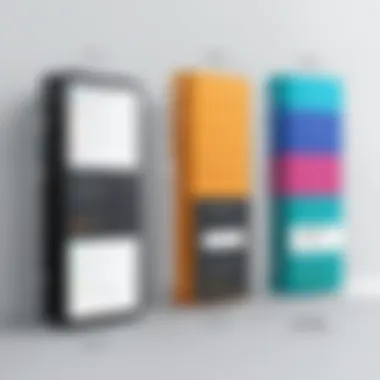Exploring Flexbox Generators: Drag and Drop Design


Intro
In the ever-evolving landscape of web design, the demand for responsive and aesthetically pleasing layouts has become paramount. Traditional coding methods often require extensive knowledge of CSS and a deep understanding of design principles. This is where flexbox generators come into play, providing an innovative solution that simplifies this process significantly. In this article, we will explore the importance of flexbox generators, particularly those featuring a drag-and-drop interface. These tools are designed to assist both beginners and seasoned developers in creating adaptive layouts with minimal effort.
Flexbox itself is a layout model in CSS that allows for easier arrangement of elements within a container. It has become a cornerstone of modern web design due to its flexibility and responsiveness. However, even with such powerful capabilities, many developers face challenges when trying to implement flexbox properties manually. This challenge has led to the rise of flexbox generators, which leverage drag-and-drop functionality to streamline design workflows.
Using these generators, users can design complex layouts that automatically adapt to various screen sizes, a critical factor in today’s mobile-first environment. The aim of this article is to dissect the core features of these flexbox generators, their performance metrics, reliability, and how they elevate the overall web design experience. We will also provide a comparative analysis of different available tools, assisting users in making informed choices when selecting a generator that aligns with their needs.
Prelims to Flexbox Generators
Flexbox generators are powerful tools designed for web developers aiming to simplify the process of creating complex layouts. As the web evolves, the demand for responsive designs has increased, making flexbox an essential part of modern web development. This introduction focuses on the particular importance of flexbox generators in streamlining layout design. Not only do these generators enhance productivity, but they also enable designers to achieve a professional appearance without extensive knowledge of CSS.
Flexbox layout enables more efficient alignment and distribution of space among items in a container, even when their sizes are unknown or dynamic. A well-structured flexbox can handle layouts that respond to different screen sizes gracefully. Thus, understanding flexbox concepts is crucial for anyone involved in web design.
Overview of Flexbox Layouts
Flexbox, or Flexible Box Layout, facilitates a one-dimensional layout model, meaning it manages the alignment of items along a single axis. This flexibility simplifies responsive design considerably. Instead of using traditional float-based layouts or CSS grid, which can be overly complex, designers can leverage flexbox to specify the direction and alignment of items more intuitively. Flexbox allows items to dynamically adjust their size and position while ensuring overall layout coherence.
Key features of flexbox include its ability to easily reorder items, change their size or alignment, and respond seamlessly to varying screen sizes. A few critical components of flexbox layouts include:
- Flex Container: The parent element that holds flex items. By applying , it activates flexbox model on its children.
- Flex Items: The direct children of a flex container. They can grow, shrink, and be aligned without requiring additional CSS properties.
Using a flexbox layout, developers can create sophisticated designs without overly convoluted code structures.
The Role of Generators in Web Design
Flexbox generators play a vital role in the web design process by offering a user-friendly interface for creating flexbox layouts, particularly through drag-and-drop functionality. These generators cater to both novice and experienced designers. For those unfamiliar with CSS, they demystify layout creation, allowing non-developers to bring their design visions to life effortlessly. Experienced developers benefit from the time savings and efficiency of using generators instead of hand-coding every layout.
The advantages of utilizing flexbox generators are several. They allow design aspects such as spacing, alignment, and responsiveness to be manipulated visually. Users can see immediate results, which helps in rapid prototyping. In addition, the code generated is typically clean and easy to understand, allowing developers to learn as they create. Thus, flexbox generators serve as educational tools in addition to being practical design aids.
"Flexbox generators can bridge the gap between design and coding, making web layout accessible for everyone."
Overall, the introduction of flexbox generators into web design workflows reflects an ongoing trend toward more user-centric design tools, which emphasize efficiency and simplicity.
Understanding Flexbox in CSS
Flexbox is a powerful layout model in CSS that simplifies the process of creating complex web layouts. It provides an efficient way to align and distribute space among items in a container, even when their sizes are unknown or dynamic. Understanding flexbox is crucial for web designers and developers, as it allows for greater flexibility and responsiveness in design without the need for floats or positioning.
Key Features of Flexbox
- Direction Control: Flexbox allows you to define the direction in which children items are placed within a flex container. This is achieved with properties like , where you can set the items to flow horizontally or vertically.
- Alignment Options: One of the most compelling features of flexbox is its ability to easily align items on the main or cross axes using properties such as , , and . These properties enable designers to control the positioning of elements effortlessly.
- Flexibility of Items: Using the property, each flex item can grow or shrink to fill the available space in the container. This means that you can create fluid layouts that adjust to varying screen sizes by simply adjusting a few properties.
- Ordering of Items: With flexbox, the visual order of items does not have to match their source order in the HTML. The property lets you rearrange items as needed, offering more control over layout and presentation.
- Nested Flex Containers: Flexbox supports nested flex containers, allowing designers to create sophisticated layouts without a complex structure of nested divs. This feature enhances organization while maintaining simplicity.
Common Use Cases of Flexbox
- Navigation Bars: Flexbox is widely used for creating responsive navigation bars. Its alignment and flexibility make it easy to space out menu items, accommodating various screen sizes.
- Grid Layouts: Designing grid layouts can often be challenging. Flexbox simplifies this by allowing items to wrap into the next row or column when there is not enough space, maintaining a clean, organized appearance.
- Card Layouts: Flexbox is ideal for creating card layouts, where visual elements need to adjust in size and alignment based on the screen. This adaptability makes it a go-to choice for modern web applications.
Flexbox can dramatically reduce the amount of CSS code needed to implement layouts, especially when compared to older layout techniques.


- Forms: Aligning form elements can be tedious with traditional methods. Flexbox enables developers to align inputs and labels easily, improving the overall user experience.
Understanding flexbox is essential for any developer focused on creating efficient, responsive web designs. With its robust features, flexbox aids in optimizing layout processes and enhancing the adaptability of web interfaces.
The Functionality of Drag and Drop
The incorporation of drag and drop functionality within flexbox generators represents a significant evolution in web design. This feature simplifies the design process, allowing users to interact with elements directly through intuitive gestures. It transforms how layouts are constructed, catering to both experienced designers and those less familiar with coding.
The primary advantage of drag and drop is its user-friendliness. Users can visually arrange components, immediately seeing the effects of their adjustments. This contrasts sharply with traditional coding methods, where changes need to be made through lines of code and then reloaded to visualize the outcome. With drag and drop, adjustments are live, prompting a more dynamic design process. Additionally, such straightforward manipulation encourages creativity, as users can experiment freely without the fear of complicated errors.
However, while drag and drop enhances accessibility, it also requires careful consideration in design execution. The interface should be responsive, as users expect a seamless experience regardless of device type. A delayed response or lack of smooth interactions can frustrate users, undermining the very purpose of this feature.
How Drag and Drop Enhances User Experience
Drag and drop functionality considerably improves user experience within flexbox generators. This feature fosters an interactive environment, where elements can be repositioned with ease. As users manipulate the layout visually, it becomes simpler to understand the connection between structure and design.
Moreover, creating responsive layouts can often resemble a daunting task for less experienced designers. By utilizing drag and drop, developers can enhance collaboration between different team members. Designers, who may not have a technical background, can contribute ideas and layouts, while more experienced developers can provide feedback in real time.
This interactive approach helps in building a shared understanding of design intent, reducing miscommunication. As a result, the overall quality of the final product is likely to improve. Investigating how various elements interact provides invaluable insight, which is often lost in the confines of traditional coding.
Technical Aspects of Implementing Drag and Drop
Adopting drag and drop functionality in flexbox generators involves several technical considerations. When implementing this feature, developers must harness JavaScript's capabilities, often making use of libraries such as jQuery UI or the native HTML5 Drag and Drop API. These tools facilitate the drag and drop interactions, ensuring that elements can be moved, resized, or deleted as required.
Another key consideration is accessibility. Designers should ensure that drag and drop actions are supported with keyboard inputs and alternative methods for those who cannot utilize a mouse effectively. This aligns with best practices in user interface design, making the tools approachable for a wider audience.
Furthermore, testing the drag and drop features across various browsers is crucial for consistency. Each browser may interpret interactions slightly differently, which can impact functionality and user experience. Ensuring that the drag and drop feature works seamlessly on all platforms is necessary for maintaining a professional standard.
Implementing drag and drop requires thought and planning, but when executed correctly, it can dramatically enhance both the usability and the overall efficiency of web design processes.
Benefits of Using Flexbox Generators
Flexbox generators have become essential tools in modern web design. They simplify the process of creating responsive layouts, enabling both seasoned developers and new users to generate effective designs. The ease of use and functionality they offer make them important in workflow efficiencies. Here, we focus on key benefits such as increased efficiency in layout creation, accessibility for non-developers, and the consistency in design principles.
Increased Efficiency in Layout Creation
Using flexbox generators greatly speeds up the process of layout creation. Instead of writing complex CSS code from scratch, designers can simply drag and drop elements into position. This method minimizes trial and error associated with traditional coding methods. By utilizing visual representations of layouts, users can immediately see changes in real-time. As a result, more time is spent on design elements rather than on debugging code.
Additionally, many generators come with preset templates, allowing developers to start from a solid foundation. This feature helps ensure that best practices are followed while still allowing for customization. By leveraging such tools, teams can meet tight deadlines without sacrificing quality.
Accessibility for Non-Developers
Flexbox generators serve as bridges for those who lack extensive programming backgrounds. Their drag and drop functionality accommodates users who may feel intimidated by coding. With simple interfaces, they offer an approachable way for non-developers to create visually appealing designs. This democratization of design tools can foster creativity from a broader audience, including small business owners or marketers who want to build their web presence.
Many generators also offer documentation and tutorials, enhancing usability further. They empower an entire team, allowing individuals to contribute to design discussions or mockups, irrespective of their technical skill level. This inclusiveness leads to a more collaborative design process.
Consistency in Design Principles


Flexbox generators also play a vital role in maintaining design consistency. By adhering to defined layouts and templates, they encourage users to apply uniform design principles across various projects. Consistency enhances the user's experience by providing recognizable patterns, which ultimately aids in navigation.
Establishing standard styles for elements like buttons and grids helps create a cohesive brand identity. Moreover, employing the same generator across projects can ensure that updates or changes carry over seamlessly. This practice reduces the likelihood of altered visual elements that can confuse users.
"Flexbox generators are integral in today's fast-paced digital environment. Their structured approach allows for consistency without luxury of time, making sure that creativity does not come at the cost of quality."
Comparative Analysis of Popular Flexbox Generators
A thorough comparative analysis of popular flexbox generators is essential in understanding how these tools can effectively enhance the web design process. As the need for responsive and flexible layouts increases, analyzing different generators allows developers and designers to choose the right tool that matches their specific needs. This section will discuss critical elements that define the usability and efficiency of these generators. Important considerations include features, user experience, and performance metrics. By evaluating these aspects, one can appreciate the unique advantages each generator offers and make informed decisions when incorporating them into a workflow.
Features of Leading Flexbox Generators
Flexbox generators come equipped with various features that aid in constructing layouts. Key features to consider include:
- Real-time Preview: Most generators allow users to see changes as they make them. This feature helps ensure design accuracy and promotes quicker iterations.
- Customizability: Different tools provide varied levels of customization. Users should look for options that allow adjustments for spacing, alignment, and directions for flex items.
- Export Options: The ability to export generated CSS is crucial. Tools that provide clean, structured, and well-commented code save time and effort in integrating designs into projects.
- Documentation and Support: Robust documentation and user support enhance the user experience. This is especially important for beginners who may need guidance while using the tool.
Each flexbox generator has unique features that cater to different user preferences and requirements, making it vital to explore these options before deciding on one.
User Experience Across Different Tools
User experience greatly influences how effectively tools are utilized. Some points to consider are:
- Interface Design: An intuitive interface allows users to navigate easily through the application. Good design minimizes confusion and promotes efficiency.
- Learning Curve: Tools should balance complexity and functionality. A steep learning curve may deter inexperienced users.
- Responsiveness: The interface's performance across devices is crucial. A generator should work seamlessly on both desktop and mobile screens.
Here are the general user experiences with some popular flexbox generators:
- CSS Flexbox Generator: Users often praise the clean and user-friendly interface, making it simple for beginners.
- Froont: This tool is lauded for its collaborative features but noted for a slightly complicated setup process.
- Sizzy: While it provides adequate tools for design, its user experience can feel overwhelming due to the excess of options available.
Performance Metrics of Each Generator
Performance metrics help determine how effectively a flexbox generator meets user needs. Important metrics include:
- Load Time: The speed at which a generator loads can affect productivity. Users prefer tools that do not lag.
- CSS Output Quality: Generated CSS must be optimized for various browsers and devices. Clean and maintainable code can reduce potential bugs in deployed systems.
- Stability and Uptime: Consistent performance is paramount. Frequent downtimes can hinder project progress and create frustration among users.
By looking at these performance metrics, developers can better understand which generators offer the most reliable setups for their design processes.
"The right generator can transform an otherwise tedious layout process into a streamlined and efficient operation, enabling developers to focus on creativity rather than technicalities."
Evaluating these elements provides insight into the competitive landscape of flexbox generators, guiding users in selecting tools that elevate their web design capabilities.
Integrating Flexbox Generators into Workflow
Integrating flexbox generators into a developer's workflow is a key aspect that can enhance productivity and streamline the process of creating responsive web layouts. These tools simplify the complex task of layout design, allowing both beginners and advanced developers to focus more on their core competencies rather than getting bogged down in intricacies. The combination of visual editing through drag and drop and the underlying flexbox properties enables rapid prototyping. Moreover, incorporating these generators into existing workflows means being able to adapt to client demands quickly and effectively.
Several specific elements stand out when considering this integration. First, the efficiency of setting up designs using drag and drop mechanics offers immediate feedback. Developers can see changes in real-time, which saves a significant amount of time compared to manual coding. Secondly, flexibility is crucial. These generators often come with pre-defined templates and customizable options, allowing users to navigate and experiment before settling on the final look. Last but not least, integrating these tools helps maintain consistency across projects. A thorough understanding of flexbox principles paired with the generators' functions results in a cohesive design across all web pages.
In summary, adopting flexbox generators not only optimizes workflows but also enhances the overall quality of web design.


Best Practices for Implementation
Implementing flexbox generators effectively in a development environment requires consideration of several best practices. By following these guidelines, developers can maximize the potential of these tools:
- Begin with Clear Goals: Understand what you want to achieve with your layout. Having a clear end goal in mind will direct your use of the generator.
- Familiarize Yourself with Flexbox: While the generator does most of the heavy lifting, a fundamental understanding of flexbox properties will help in making modifications post-generation.
- Utilize Templates Wisely: Most generators offer templates. Choose those that closely align with your vision, and customize them as needed rather than starting from scratch.
- Document Your Process: Keep track of the design decisions made within the generator. This can help in future revisions and in maintaining consistency.
- Regularly Update the Tool: Flexbox generators evolve with time. Ensure you have the latest version, which might include new features or bug fixes that can enhance your work.
Following these practices ensures that the user takes full advantage of what flexbox generators have to offer.
Common Pitfalls to Avoid
While using flexbox generators provides various advantages, there are also pitfalls that developers should aim to avoid. Here is a list of common issues:
- Over-Reliance on Visual Tools: While drag-and-drop interfaces are useful, it's important not to rely solely on them. Understanding the code behind the designs is crucial for making adjustments later.
- Ignoring Accessibility Standards: Flexbox layouts can be visually appealing but may complicate accessibility. Always check if the layout works well for all users, especially those utilizing assistive technologies.
- Neglecting Browser Compatibility: Some styling may render differently across browsers. Testing your designs in various browsers is essential before deployment.
- Forgetting About Mobile Design: Ensure your designs are mobile-responsive. Many generators have options for this, but it must not be overlooked during the design process.
- Skipping Code Review: Generated code can be messy or contain unnecessary elements. Review and clean your code to improve performance and maintainability.
By recognizing and avoiding these pitfalls, developers can take full advantage of the benefits flexbox generators offer without compromising the integrity of their web designs.
Proper integration of flexbox generators into a workflow can lead to enhanced productivity and better web design outcomes.
Future Trends in Flexbox Generators
The landscape of web design is constantly evolving, especially with the rise of flexbox generators that incorporate drag and drop functionalities. This section delves into the future trends shaping these tools, highlighting their significance in modern web development. As technology continues to advance, flexbox generators will adapt to meet the changing needs of users. This adaptation is crucial for maintaining efficiency, responsiveness, and user-friendliness in design workflows.
Emerging Technologies and Improvements
The future of flexbox generators is closely tied to emerging technologies. These advancements can drastically improve performance and usability. For instance, integrating artificial intelligence can automate layout suggestions based on user preferences and design trends. Additionally, tools may incorporate real-time collaborative features, enabling multiple developers to work on a project simultaneously. This capability not only enhances productivity but also fosters an environment for shared creativity.
Furthermore, as web standards evolve, flexbox generators will likely integrate new CSS features, like container queries or CSS Grid Layout, providing even more flexibility in design options.
"Emerging technology in web design has the potential to redefine how creators interact with layout tools, making the design process more intuitive."
Predicted Advances in User Interaction
User interaction is at the core of any design tool. Future advancements will focus on enhancing the way users engage with flexbox generators. Predictive features will become standard, allowing the tool to suggest design elements based on previously used patterns. This leads to quicker adjustments and a more seamless experience.
Moreover, touch and gesture control will gain prominence, especially with the increasing use of tablets and mobile devices for design tasks. This evolution will necessitate a reconsideration of user interfaces to accommodate intuitive gestures that align with the drag and drop methodology.
The feedback mechanisms provided by these tools will also become more sophisticated. Users will benefit from instant previews and adjustments, helping to visualize changes in real-time rather than after implementation.
In summary, examining future trends in flexbox generators reveals a trajectory aimed at improving both operational efficiency and user satisfaction. As technology progresses, the tools developers rely on will transform, laying the groundwork for even more innovative design solutions.
Ending
The significance of flexbox generators in modern web design cannot be underestimated. They simplify the layout creation process while empowering users to craft responsive designs effortlessly. Throughout this article, we have explored various aspects that contribute to their efficiency. Flexbox generators not only alleviate the complexity of coding but also democratize design for a diverse audience, ranging from beginners to advanced users.
Summarizing the Impact of Flexbox Generators
Flexbox generators have revolutionized how developers and designers approach layout creation. These tools enable users to visualize their layouts in real-time, reducing the time spent on adjustments and refinements. As a result, productivity increases significantly. Users can focus on creative aspects rather than getting bogged down by technical syntax. The accessibility of flexbox generators fosters greater experimentation, leading to more innovative designs.
Moreover, the consistency that these tools maintain across various devices ensures that designs are responsive, which is paramount in today’s web environment. This also builds redundancy in design principles, allowing non-developers to participate in the design process without extensive training. As the tech landscape continues to shift, the role of flexbox generators will likely expand further, influencing educational practices and professional workflows alike.
Final Thoughts on Design Efficiency
Design efficiency in web development is critical, and the integration of flexbox generators plays a substantial role in achieving this objective. The drag and drop capability provides intuitive usability, making it possible for anyone to conceive layouts that function seamlessly across platforms. Furthermore, educators and industry professionals can leverage these tools to teach flexbox principles without overwhelming students with technical jargon.







